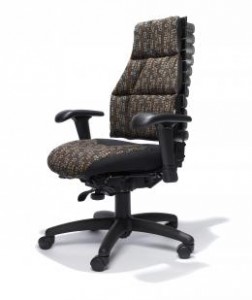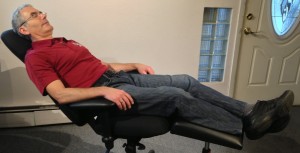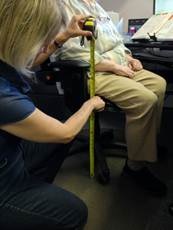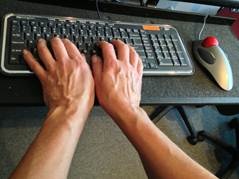 Q: I am writing since I know you are an expert in the good for you back furniture field. I wanted to know if you had any suggestions for living room furniture that may be good for backs. If you could point me in the right direction I would be grateful!!! (DT, Dallas TX)
Q: I am writing since I know you are an expert in the good for you back furniture field. I wanted to know if you had any suggestions for living room furniture that may be good for backs. If you could point me in the right direction I would be grateful!!! (DT, Dallas TX)
A: I don’t have any hard recommendations, but I do have some suggestions beyond the obvious need for the overall fit to be good (seat depth matching thigh length, matching lumbar support contour height and shape, shoulder contact pattern supportive but with good head posture and without inward shoulder rotation).
First, avoid seating with soft deep cushions, or cushions that easily break down over time becoming soft and saggy. There are two postural reasons: soft cushions tend to be too low and also create the “sitting in a bucket” effect. Both issues promote a “C” spine posture with extra stress on knees and hips due to the low height.
Here is where quality really counts (especially the quality that you can’t see). We bought a decent, good quality, sofa set about 15 years ago. It had wonderfully firm cushions with a good fit. However, within about 5 years the cushions softened up and now I no longer sit on it (Deb seems to do OK with extra pillows). We still like the look of it in our space, but…
I almost exclusively use my Ekornes Stressless Recliner. Ekornes seems to do a good job on the quality (I have not noticed any cushion degradation in the 10+ years I have been using it). They are available as singles or sofas, in a very wide variety of styles, shapes and sizes, so it is important to take your time and find the right fit for you. Unfortunately, the model that fits me best has been discontinued, but you can take a look at what they are doing now at: http://www.ekornes.com/us/stressless-recliners/stressless-chelsea-stressless-mayfair-stressless-kensington/mayfair#tab_stressless_sizeguide .
Note the construction style: the best ones have a layer of fairy dense foam supported by a substructure that won’t sag over time (in fact, this kind of reminds me of our office chairs).
Another approach is to find a sofa with a good seat structure which uses an assortment of free pillows that can be individually arranged to get the desired fit for the back. This provides a customizable and flexible solution, if you like the look. It also makes it very easy to turn the seat into a narrow bed by simply removing the back support pillows. But you will need to constantly rearrange the pillows to make sure your upper torso is well supported when relaxing.
When you are shopping around, I highly recommend that once you have made a tentative selection, take your favorite e-reader (or whatever you like doing for entertainment when seated in your living room) and camp out in the showroom. Pay close attention to what your body is telling you as you sit longer.
An interesting factoid: standing and walking stresses your back in the opposite way that sitting does. As a result, a bad seat will feel great … for a short while after being on your feet. Give it at least 20 minutes to hear what your body has to say, and longer than an hour might be prudent before making a larger investment in a whole set. Do this, even if they offer a free return policy (which is nice), since most of us would hesitate to send it back once it is in place.
For those who truly value function, and can live with a more office-y look in their home, a fully adjustable high back office chair can make a very effective custom fit recliner. Just this past week, I fit a client for such a chair for home use since she could not find anything in the home furnishings market that worked as well. We customized a chair and footstool that provided just the right back support and leg elevation that met her needs.
Chris Krebs
chris@ergoAK.com

PS- I would gladly weigh in on the fit if you email or text me some profile pictures of you standing and then sitting in the furniture you think is in the running (my blog readers are included in this invitation).




